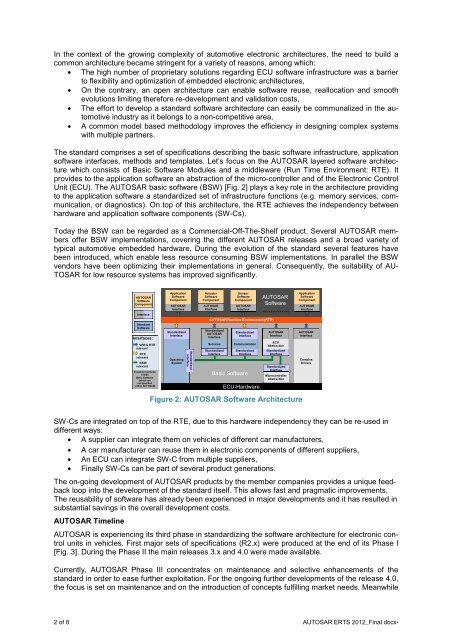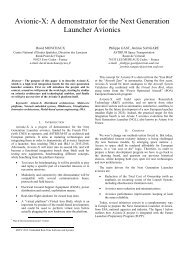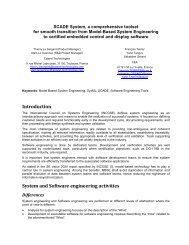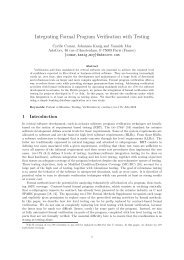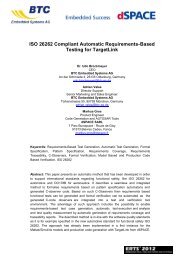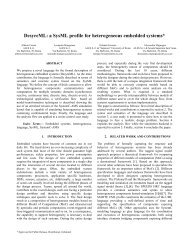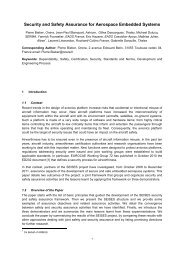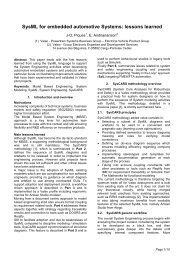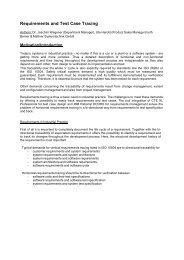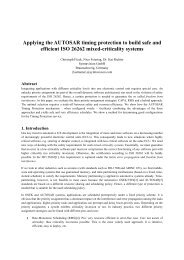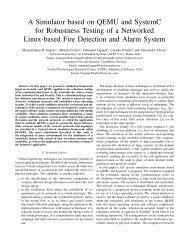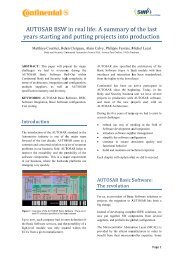AUTOSAR: Achievements, roll-out, perspectives
AUTOSAR: Achievements, roll-out, perspectives
AUTOSAR: Achievements, roll-out, perspectives
You also want an ePaper? Increase the reach of your titles
YUMPU automatically turns print PDFs into web optimized ePapers that Google loves.
In the context of the growing complexity of automotive electronic architectures, the need to build a<br />
common architecture became stringent for a variety of reasons, among which:<br />
• The high number of proprietary solutions regarding ECU software infrastructure was a barrier<br />
to flexibility and optimization of embedded electronic architectures,<br />
• On the contrary, an open architecture can enable software reuse, reallocation and smooth<br />
evolutions limiting therefore re-development and validation costs,<br />
• The effort to develop a standard software architecture can easily be communalized in the automotive<br />
industry as it belongs to a non-competitive area,<br />
• A common model based methodology improves the efficiency in designing complex systems<br />
with multiple partners.<br />
The standard comprises a set of specifications describing the basic software infrastructure, application<br />
software interfaces, methods and templates. Let’s focus on the <strong>AUTOSAR</strong> layered software architecture<br />
which consists of Basic Software Modules and a middleware (Run Time Environment: RTE). It<br />
provides to the application software an abstraction of the micro-cont<strong>roll</strong>er and of the Electronic Control<br />
Unit (ECU). The <strong>AUTOSAR</strong> basic software (BSW) [Fig. 2] plays a key role in the architecture providing<br />
to the application software a standardized set of infrastructure functions (e.g. memory services, communication,<br />
or diagnostics). On top of this architecture, the RTE achieves the independency between<br />
hardware and application software components (SW-Cs).<br />
Today the BSW can be regarded as a Commercial-Off-The-Shelf product. Several <strong>AUTOSAR</strong> members<br />
offer BSW implementations, covering the different <strong>AUTOSAR</strong> releases and a broad variety of<br />
typical automotive embedded hardware. During the evolution of the standard several features have<br />
been introduced, which enable less resource consuming BSW implementations. In parallel the BSW<br />
vendors have been optimizing their implementations in general. Consequently, the suitability of AU-<br />
TOSAR for low resource systems has improved significantly.<br />
Figure 2: <strong>AUTOSAR</strong> Software Architecture<br />
SW-Cs are integrated on top of the RTE, due to this hardware independency they can be re-used in<br />
different ways:<br />
• A supplier can integrate them on vehicles of different car manufacturers,<br />
• A car manufacturer can reuse them in electronic components of different suppliers,<br />
• An ECU can integrate SW-C from multiple suppliers,<br />
• Finally SW-Cs can be part of several product generations.<br />
The on-going development of <strong>AUTOSAR</strong> products by the member companies provides a unique feedback<br />
loop into the development of the standard itself. This allows fast and pragmatic improvements.<br />
The reusability of software has already been experienced in major developments and it has resulted in<br />
substantial savings in the overall development costs.<br />
<strong>AUTOSAR</strong> Timeline<br />
<strong>AUTOSAR</strong><br />
Software<br />
Component<br />
Interface<br />
Standard<br />
Software<br />
Interfaces:<br />
VFB & RTE<br />
relevant<br />
RTE<br />
relevant<br />
BSW<br />
relevant<br />
Possible interfaces<br />
inside<br />
Basic Software<br />
(which are<br />
not specified<br />
within <strong>AUTOSAR</strong>)<br />
Application<br />
Software<br />
Component<br />
<strong>AUTOSAR</strong><br />
Interface<br />
Standardized<br />
Interface<br />
Operating<br />
System<br />
Standardized<br />
Interface<br />
Actuator<br />
Software<br />
Component<br />
<strong>AUTOSAR</strong><br />
Interface<br />
Sensor<br />
Software<br />
Component<br />
<strong>AUTOSAR</strong> Runtime Environment (RTE)<br />
Standardized<br />
<strong>AUTOSAR</strong><br />
Interface<br />
Services<br />
Standardized<br />
Interface<br />
Basic Software<br />
ECU-Hardware<br />
<strong>AUTOSAR</strong><br />
Software<br />
..............<br />
Standardized<br />
Interface<br />
Application<br />
Software<br />
Component<br />
<strong>AUTOSAR</strong> is experiencing its third phase in standardizing the software architecture for electronic control<br />
units in vehicles. First major sets of specifications (R2.x) were produced at the end of its Phase I<br />
[Fig. 3]. During the Phase II the main releases 3.x and 4.0 were made available.<br />
Currently, <strong>AUTOSAR</strong> Phase III concentrates on maintenance and selective enhancements of the<br />
standard in order to ease further exploitation. For the ongoing further developments of the release 4.0,<br />
the focus is set on maintenance and on the introduction of concepts fulfilling market needs. Meanwhile<br />
2 of 8 <strong>AUTOSAR</strong> ERTS 2012_Final.docx-<br />
<strong>AUTOSAR</strong><br />
Interface<br />
Standardized<br />
Interface<br />
Communication<br />
Standardized<br />
Interface<br />
<strong>AUTOSAR</strong><br />
Interface<br />
ECU<br />
Abstraction<br />
Standardized<br />
Interface<br />
Microcont<strong>roll</strong>er<br />
Abstraction<br />
<strong>AUTOSAR</strong><br />
Interface<br />
<strong>AUTOSAR</strong><br />
Interface<br />
Complex<br />
Drivers


